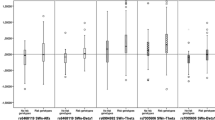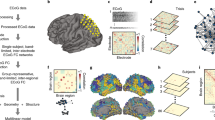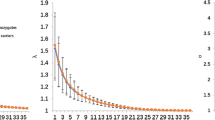Abstract
A deficit in task-related functional connectivity modulation from electroencephalogram (EEG) has been described in schizophrenia. The use of measures of neuronal connectivity as an intermediate phenotype may allow identifying genetic factors involved in these deficits, and therefore, establishing underlying pathophysiological mechanisms. Genes involved in neuronal excitability and previously associated with the risk for schizophrenia may be adequate candidates in relation to functional connectivity alterations in schizophrenia. The objective was to study the association of two genes of voltage-gated ion channels (CACNA1C and KCNH2) with the functional modulation of the cortical networks measured with EEG and graph-theory parameter during a cognitive task, both in individuals with schizophrenia and healthy controls. Both CACNA1C (rs1006737) and KCNH2 (rs3800779) were genotyped in 101 controls and 50 schizophrenia patients. Small-world index (SW) was calculated from EEG recorded during an odd-ball task in two different temporal windows (pre-stimulus and response). Modulation was defined as the difference in SW between both windows. Genetic, group and their interaction effects on SW in the pre-stimulus window and in modulation were evaluated using ANOVA. The CACNA1C genotype was not associated with SW properties. KCNH2 was significantly associated with SW modulation. Healthy subjects showed a positive SW modulation irrespective of the KCNH2 genotype, whereas within patients allele-related differences were observed. Patients carrying the KCNH2 risk allele (A) presented a negative SW modulation and non-carriers showed SW modulation similar to the healthy subjects. Our data suggest that KCNH2 genotype contributes to the efficient modulation of brain electrophysiological activity during a cognitive task in schizophrenia patients.


Similar content being viewed by others
References
Braff DL, Freedman R, Schork NJ, Gottesman II (2007) Deconstructing schizophrenia: an overview of the use of endophenotypes in order to understand a complex disorder. Schizophr Bull 33:21–32. https://doi.org/10.1093/schbul/sbl049
Owens EM, Bachman P, Glahn DC, Bearden CE (2016) Electrophysiological endophenotypes for schizophrenia. Harv Rev Psychiatry 24:129–147
Turetsky BI, Dress EM, Braff DL et al (2015) The utility of P300 as a schizophrenia endophenotype and predictive biomarker: clinical and socio-demographic modulators in COGS-2. Schizophr Res 163:53–62. https://doi.org/10.1016/j.schres.2014.09.024
Uhlhaas PJ, Singer W (2010) Abnormal neural oscillations and synchrony in schizophrenia. Nat Rev Neurosci 11:100–113
Borsboom D, Cramer AOJ, Schmittmann VD et al (2011) The small world of psychopathology. PLoS One https://doi.org/10.1371/journal.pone.0027407
Gomez-Pilar J, Lubeiro A, Poza J et al (2017) Functional EEG network analysis in schizophrenia: evidence of larger segregation and deficit of modulation. Prog Neuro Psychopharmacol Biol Psychiatry 76:116–123. https://doi.org/10.1016/j.pnpbp.2017.03.004
Micheloyannis S (2012) Graph-based network analysis in schizophrenia. World J Psychiatry 2:1. https://doi.org/10.5498/wjp.v2.i1.1
Shim M, Kim DW, Lee SH, Im CH (2014) Disruptions in small-world cortical functional connectivity network during an auditory oddball paradigm task in patients with schizophrenia. Schizophr Res 156:197–203. https://doi.org/10.1016/j.schres.2014.04.012
Whitfield-Gabrieli S, Thermenos HW, Milanovic S et al (2009) Hyperactivity and hyperconnectivity of the default network in schizophrenia and in first-degree relatives of persons with schizophrenia. Proc Natl Acad Sci 106:1279–1284. https://doi.org/10.1073/pnas.0809141106
Bassett DS, Bullmore ET, Meyer-Lindenberg A et al (2009) Cognitive fitness of cost-efficient brain functional networks. Proc Natl Acad Sci USA 106:11747–11752. https://doi.org/10.1073/pnas.0903641106
Achard S, Bullmore E (2007) Efficiency and cost of economical brain functional networks. PLoS Comput Biol 3:e17. https://doi.org/10.1371/journal.pcbi.0030017
Buzsáki G (2006) Diversity of cortical functions. In: Rhythms of the brain. Oxford University Press, New York, pp 21–79
Stam CJ, de Haan W, Daffertshofer A et al (2009) Graph theoretical analysis of magnetoencephalographic functional connectivity in Alzheimer’s disease. Brain 132:213–224. https://doi.org/10.1093/brain/awn262
Sullivan PF, Kendler KS, Neale MC (2003) Schizophrenia as a complex trait: evidence from a meta-analysis of twin studies. Arch Gen Psychiatry 60:1187–1192. https://doi.org/10.1001/archpsyc.60.12.1187
Walton E, Turner JA, Ehrlich S (2013) Neuroimaging as a potential biomarker to optimize psychiatric research and treatment. Int Rev Psychiatry 25:619–631. https://doi.org/10.3109/09540261.2013.816659
Smit DJA, Posthuma D, Boomsma DI, De Geus EJC (2005) Heritability of background EEG across the power spectrum. Psychophysiology 42:691–697. https://doi.org/10.1111/j.1469-8986.2005.00352.x
Van Beijsterveldt CEM, Van Baal GCM (2002) Twin and family studies of the human electroencephalogram: a review and a meta-analysis. Biol Psychol 61:111–138
De Geus EJC (2010) From genotype to EEG endophenotype: a route for post-genomic understanding of complex psychiatric disease? Genome Med 2(9):63
Schutte NM, Hansell NK, de Geus EJC et al (2013) Heritability of resting state EEG functional connectivity patterns. Twin Res Hum Genet 16:962–969. https://doi.org/10.1017/thg.2013.55
Smit DJA, Stam CJ, Posthuma D et al (2008) Heritability of “small-world” networks in the brain: a graph theoretical analysis of resting-state EEG functional connectivity. Hum Brain Mapp 29:1368–1378. https://doi.org/10.1002/hbm.20468
Ripke S, Dushlaine CO, Chambert K et al (2013) Genome-wide association analysis identifies 13 new risk loci for schizophrenia. Nat Genet. https://doi.org/10.1038/ng.2742.Genome-wide
Pardiñas AF, Holmans P, Pocklington AJ et al (2018) Common schizophrenia alleles are enriched in mutation-intolerant genes and in regions under strong background selection. Nat Genet 50:381–389. https://doi.org/10.1038/s41588-018-0059-2
Narayanan B, Soh P, Calhoun VD et al (2015) Multivariate genetic determinants of EEG oscillations in schizophrenia and psychotic bipolar disorder from the BSNIP study. Transl Psychiatry https://doi.org/10.1038/tp.2015.76
Del Re EC, Bergen SE, Mesholam-Gately RI et al (2014) Analysis of schizophrenia-related genes and electrophysiological measures reveals ZNF804A association with amplitude of P300b elicited by novel sounds. Transl Psychiatry https://doi.org/10.1038/tp.2013.117
Kang C, Yang X, Xu X et al (2012) Association study of neuregulin 1 gene polymorphisms with auditory p300 in schizophrenia. Am J Med Genet Part B Neuropsychiatr Genet 159 B:422–428. https://doi.org/10.1002/ajmg.b.32045
Striessnig J, Pinggera A, Kaur G et al (2014) L-type Ca2 + channels in heart and brain. Wiley Interdiscip Rev Membr Transp Signal 3:15–38. https://doi.org/10.1002/wmts.102
Gomez-Ospina N, Tsuruta F, Barreto-Chang O et al (2006) The C terminus of the L-type voltage-gated calcium channel CaV1.2 encodes a transcription factor. Cell 127:591–606. https://doi.org/10.1016/j.cell.2006.10.017
Simms BA, Zamponi W (2014) Neuronal voltage-gated calcium channels: structure, function, and dysfunction. Neuron 82:24–45. https://doi.org/10.1016/j.neuron.2014.03.016
Saliba RS, Gu Z, Yan Z, Moss SJ (2009) Blocking L-type voltage-gated Ca2 + channels with dihydropyridines reduces ??-aminobutyric acid type A receptor expression and synaptic inhibition. J Biol Chem 284:32544–32550. https://doi.org/10.1074/jbc.M109.040071
Kabir ZD, Che A, Fischer DK et al (2017) Rescue of impaired sociability and anxiety-like behavior in adult cacna1c-deficient mice by pharmacologically targeting eIF2α. Mol Psychiatry 22:1096–1109. https://doi.org/10.1038/mp.2017.124
Cross-Disorder Group of the Psychiatric Genomics Consortium C-DG of the PG (2013) Identification of risk loci with shared effects on five major psychiatric disorders: a genome-wide analysis. Lancet 381:1371–1379. https://doi.org/10.1016/S0140-6736(12)62129-1
Ripke S, Neale BM, Corvin A et al (2014) Biological insights from 108 schizophrenia-associated genetic loci. Nature 511:421–427. https://doi.org/10.1038/nature13595
Guan F, Zhang B, Yan T et al (2014) MIR137 gene and target gene CACNA1C of miR-137 contribute to schizophrenia susceptibility in Han Chinese. Schizophr Res 152:97–104. https://doi.org/10.1016/j.schres.2013.11.004
He K, An Z, Wang Q et al (2014) CACNA1C, schizophrenia and major depressive disorder in the Han Chinese population. Br J Psychiatry 204:36–39. https://doi.org/10.1192/bjp.bp.113.126979
Ivorra JL, Rivero O, Costas J et al (2014) Replication of previous genome-wide association studies of psychiatric diseases in a large schizophrenia case-control sample from Spain. Schizophr Res 159:107–113. https://doi.org/10.1016/j.schres.2014.07.004
Nie F, Wang X, Zhao P et al (2015) Genetic analysis of SNPs in CACNA1C and ANK3 gene with schizophrenia: a comprehensive meta-analysis. Am J Med Genet Part B Neuropsychiatr Genet 168:637–648. https://doi.org/10.1002/ajmg.b.32348
Bigos KL, Mattay VS, Callicott JH et al (2010) Genetic variation in CACNA1C affects brain circuitries related to mental illness. Arch Gen Psychiatry 67:939–945. https://doi.org/10.1001/archgenpsychiatry.2010.96
Green EK, Grozeva D, Jones I et al (2010) The bipolar disorder risk allele at CACNA1C also confers risk of recurrent major depression and of schizophrenia. Mol Psychiatry 15:1016–1022. https://doi.org/10.1038/mp.2009.49
Nyegaard M, Demontis D, Foldager L et al (2010) CACNA1C (rs1006737) is associated with schizophrenia. Mol Psychiatry 15:119–121
Wolf C, Mohr H, Schneider-Axmann T et al (2014) CACNA1C genotype explains interindividual differences in amygdala volume among patients with schizophrenia. Eur Arch Psychiatry Clin Neurosci 264:93–102. https://doi.org/10.1007/s00406-013-0427-y
Kempton MJ, Stahl D, Williams SCR, DeLisi LE (2010) Progressive lateral ventricular enlargement in schizophrenia: a meta-analysis of longitudinal MRI studies. Schizophr Res 120:54–62. https://doi.org/10.1016/j.schres.2010.03.036
Wang F, Mcintosh AM, He Y et al (2011) The association of genetic variation in CACNA1C with structure and function of a frontotemporal system. Bipolar Disord 13:696–700. https://doi.org/10.1111/j.1399-5618.2011.00963.x
Lancaster TM, Foley S, Tansey KE et al (2016) CACNA1C risk variant is associated with increased amygdala volume. Eur Arch Psychiatry Clin Neurosci 266:269–275. https://doi.org/10.1007/s00406-015-0609-x
Huang L, Mo Y, Sun X et al (2016) The impact of CACNA1C allelic variation on regional gray matter volume in Chinese population. Am J Med Genet B Neuropsychiatr Genet 171B:396–401. https://doi.org/10.1002/ajmg.b.32418
Erk S, Meyer-Lindenberg A, Schnell K et al (2010) Brain function in carriers of a genome-wide supported bipolar disorder variant. Arch Gen Psychiatry 67:803–811. https://doi.org/10.1001/archgenpsychiatry.2010.94
Paulus FM, Bedenbender J, Krach S et al (2014) Association of rs1006737 in CACNA1C with alterations in prefrontal activation and fronto-hippocampal connectivity. Hum Brain Mapp 35:1190–1200. https://doi.org/10.1002/hbm.22244
Gurung R, Prata DP (2015) What is the impact of genome-wide supported risk variants for schizophrenia and bipolar disorder on brain structure and function? A systematic review. Psychol Med 45:2461–2480
Radua J, Surguladze SA, Marshall N et al (2013) The impact of CACNA1C allelic variation on effective connectivity during emotional processing in bipolar disorder. Mol Psychiatry 18:526–527
Eckart N, Song Q, Yang R et al (2016) Functional characterization of schizophrenia-associated variation in CACNA1C. PLoS One https://doi.org/10.1371/journal.pone.0157086
Yoshimizu T, Pan JQ, Mungenast AE et al (2015) Functional implications of a psychiatric risk variant within CACNA1C in induced human neurons. Mol Psychiatry 20:162–169. https://doi.org/10.1038/mp.2014.143
Ji H, Tucker KR, Putzier I et al (2012) Functional characterization of ether-a-go-go-related gene potassium channels in midbrain dopamine neurons—implications for a role in depolarization block. Eur J Neurosci 36:2906–2916. https://doi.org/10.1111/j.1460-9568.2012.08190.x
Pessia M, Servettini I, Panichi R et al (2008) ERG voltage-gated K + channels regulate excitability and discharge dynamics of the medial vestibular nucleus neurones. J Physiol 586:4877–4890. https://doi.org/10.1113/jphysiol.2008.155762
Huffaker SJ, Chen J, Nicodemus KK et al (2009) A primate-specific, brain isoform of KCNH2 affects cortical physiology, cognition, neuronal repolarization and risk of schizophrenia. Nat Med 15:509–518. https://doi.org/10.1038/nm.1962
Hashimoto R, Ohi K, Yasuda Y et al (2013) The KCNH2 gene is associated with neurocognition and the risk of schizophrenia. World J Biol Psychiatry 14:114–120. https://doi.org/10.3109/15622975.2011.604350
Carr GV, Chen J, Yang F et al (2016) KCNH2-3.1 expression impairs cognition and alters neuronal function in a model of molecular pathology associated with schizophrenia. Mol Psychiatry https://doi.org/10.1038/mp.2015.219
The 1000 Genomes Project Consortium, Abecasis GR, Auton A, Brooks LD, DePristo MA, Durbin RM, Handsaker RE, Kang HM, Marth GT, McVean GA (2012) An integrated map of genetic variation from 1,092 human genomes. Nature 491(7422):56–65. https://doi.org/10.1038/nature11632
Bachiller A, Poza J, Gómez C et al (2015) A comparative study of event-related coupling patterns during an auditory oddball task in schizophrenia. J Neural Eng 12:16007. https://doi.org/10.1088/1741-2560/12/1/016007
Núñez P, Poza J, Bachiller A et al (2017) Exploring non-stationarity patterns in schizophrenia: neural reorganization abnormalities in the alpha band. J Neural Eng https://doi.org/10.1088/1741-2552/aa6e05
Gomez-Pilar J, Poza J, Bachiller A et al (2015) Neural network reorganization analysis during an auditory oddball task in schizophrenia using wavelet entropy. Entropy 17:5241–5256. https://doi.org/10.3390/e17085241
Tallon-Baudry C, Bertrand O, Delpuech C, Pernier J (1996) Stimulus specificity of phase-locked and non-phase-locked 40 Hz visual responses in human. J Neurosci 16:4240–4249. https://doi.org/10.1016/j.neuropsychologia.2011.02.038
Nunez PL, Srinivasan R, Westdorp AF et al (1997) EEG coherency. I: statistics, reference electrode, volume conduction, Laplacians, cortical imaging, and interpretation at multiple scales. Electroencephalogr Clin Neurophysiol 103:499–515
Yener GG, Başar E (2013) Brain oscillations as biomarkers in neuropsychiatric disorders: following an interactive panel discussion and synopsis. Suppl Clin Neurophysiol 62:343–363. https://doi.org/10.1016/B978-0-7020-5307-8.00016-8
Rubinov M, Sporns O (2010) Complex network measures of brain connectivity: uses and interpretations. Neuroimage 52:1059–1069. https://doi.org/10.1016/j.neuroimage.2009.10.003
Erdfelder E, Faul F, Buchner A et al (2009) Statistical power analyses using G*Power 3.1: test for correlation and regression analyses. Behav Res Methods 41:1149–1160. https://doi.org/10.3758/BRM.41.4.1149
Cosgrove D, Mothersill O, Kendall K et al (2017) Cognitive characterization of schizophrenia risk variants involved in synaptic transmission: evidence of CACNA1C’s role in working memory. Neuropsychopharmacology 42:2612–2622. https://doi.org/10.1038/npp.2017.123
Zhang SY, Hu Q, Tang T et al (2017) Role of CACNA1C gene polymorphisms and protein expressions in the pathogenesis of schizophrenia: a case-control study in a Chinese population. Neurol Sci 38:1393–1403. https://doi.org/10.1007/s10072-017-2963-0
Woon PS, Sum MY, Kuswanto CN et al (2014) CACNA1C genomewide supported psychosis genetic variation affects cortical brain white matter integrity in chinese patients with schizophrenia. J Clin Psychiatry 75:e1284–e1290. https://doi.org/10.4088/JCP.13m08777
Dietsche B, Backes H, Laneri D et al (2014) The impact of a CACNA1C gene polymorphism on learning and hippocampal formation in healthy individuals: a diffusion tensor imaging study. Neuroimage 89:256–261. https://doi.org/10.1016/j.neuroimage.2013.11.030
Kabir ZD, Martínez-Rivera A, Rajadhyaksha AM (2017) From gene to behavior: L-type calcium channel mechanisms underlying neuropsychiatric symptoms. Neurotherapeutics 14:588–613
Frazier TW, Youngstrom EA, Frankel BA et al (2014) Candidate gene associations with mood disorder, cognitive vulnerability, and fronto-limbic volumes. Brain Behav 4:418–430. https://doi.org/10.1002/brb3.226
Backes H, Dietsche B, Nagels A et al (2014) Genetic variation in CACNA1C affects neural processing in major depression. J Psychiatr Res 53:38–46. https://doi.org/10.1016/j.jpsychires.2014.02.003
Dedic N, Pöhlmann ML, Richter JS et al (2018) Cross-disorder risk gene CACNA1C differentially modulates susceptibility to psychiatric disorders during development and adulthood. Mol Psychiatry 23:533–543. https://doi.org/10.1038/mp.2017.133
Krautheim JT, Straube B, Dannlowski U et al (2018) Outgroup emotion processing in the vACC is modulated by childhood trauma and CACNA1C risk variant. Soc Cogn Affect Neurosci 13:341–348. https://doi.org/10.1093/scan/nsy004
Kircher T, Wöhr M, Nenadic I et al (2018) Neurobiology of the major psychoses: a translational perspective on brain structure and function—the FOR2107 consortium. Eur Arch Psychiatry Clin Neurosci. https://doi.org/10.1007/s00406-018-0943-x
Ward LD, Kellis M (2012) HaploReg: a resource for exploring chromatin states, conservation, and regulatory motif alterations within sets of genetically linked variants. Nucleic Acids Res https://doi.org/10.1093/nar/gkr917
Molina V, Blanco JA (2013) A proposal for reframing schizophrenia research. J Nerv Ment Dis 201:744–752. https://doi.org/10.1097/NMD.0b013e3182a21444
Lubeiro A, Rueda C, Hernández JA et al (2016) Identification of two clusters within schizophrenia with different structural, functional and clinical characteristics. Prog Neuro Psychopharmacol Biol Psychiatry https://doi.org/10.1016/j.pnpbp.2015.06.015
Arnedo J, Svrakic DM, Del Val C et al (2015) Uncovering the hidden risk architecture of the schizophrenias: confirmation in three independent genome-wide association studies. Am J Psychiatry 172:139–153. https://doi.org/10.1176/appi.ajp.2014.14040435
Acknowledgements
This work was supported by: (1) the Instituto Carlos III through the projects PI11/02708, PI11/02203, PI15/00299 and PI15/01420 (co-funded by the European Regional Development Fund/European Social Fund “Investing in your future”); (2) the Gerencia Regional de Salud de Castilla y León (GRS 932/A/14 and GRS 1134/A/15) grants; (3) Consejería de Educación de la Junta de Castilla y León (VA059U13, VA037U16); (4) European Commission and FEDER under Project “Análisis y correlación entre genoma completo y la actividad cerebral para la ayuda en el diagnóstico de la enfermedad de Alzheimer” (Cooperation Program Interreg V-A Spain-Portugal POCTEP 2014–2020); (5) predoctoral fellowships to A. Lubeiro (Consejería de Educación Junta de Castilla y León and European Social Fund’) and to J. Gomez-Pilar (University of Valladolid); (6) a Sara Borrell contract to M Fatjó-Vilas (CD16/00264); (7) the Comissionat per a Universitats i Recerca del DIUE, of the Generalitat de Catalunya regional authorities (2017SGR1271).
Author information
Authors and Affiliations
Corresponding authors
Ethics declarations
Conflict of interest
On behalf of all authors, the corresponding author states that there is no conflict of interest.
Ethical approval
All participants provided written informed consent to participate in the study. It was approved by the ethical committee of the involved hospitals endorsed the study according to The Code of Ethics of the World Medical Association (Helsinki Declaration of 1975, as revised in 2008).
Electronic supplementary material
Below is the link to the electronic supplementary material.
Rights and permissions
About this article
Cite this article
Lubeiro, A., Fatjó-Vilas, M., Guardiola, M. et al. Analysis of KCNH2 and CACNA1C schizophrenia risk genes on EEG functional network modulation during an auditory odd-ball task. Eur Arch Psychiatry Clin Neurosci 270, 433–442 (2020). https://doi.org/10.1007/s00406-018-0977-0
Received:
Accepted:
Published:
Issue Date:
DOI: https://doi.org/10.1007/s00406-018-0977-0




